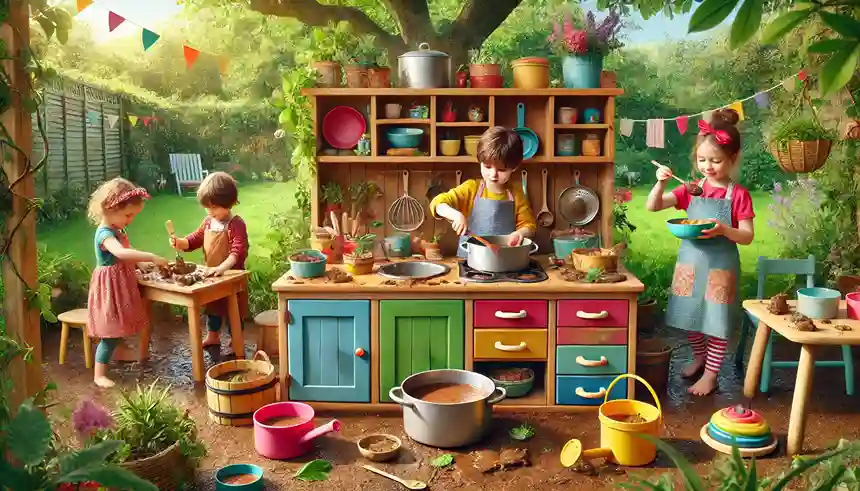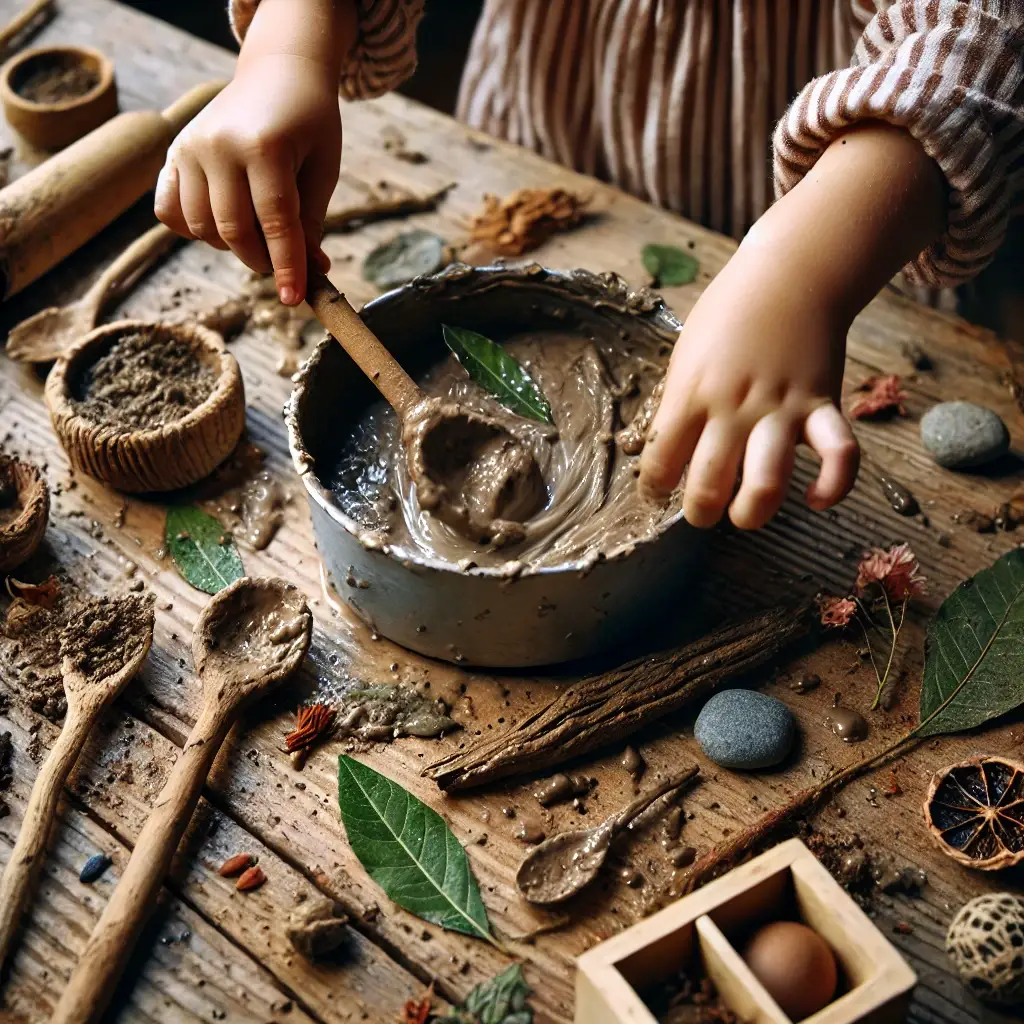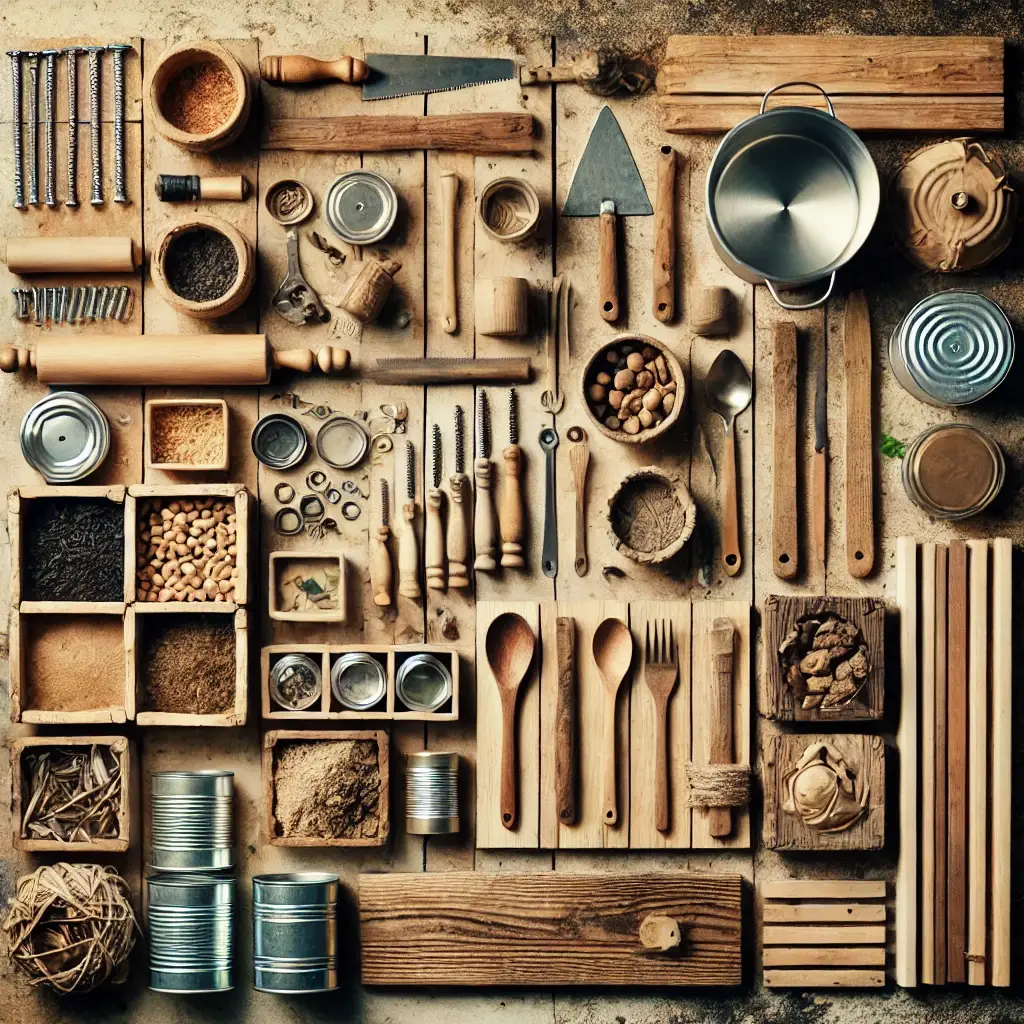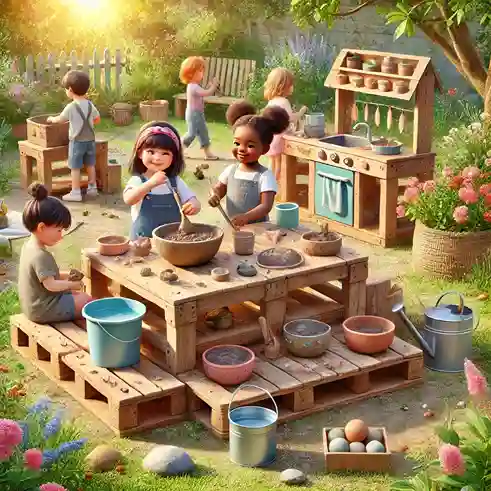Introduction
Today, engaging children in outdoor play and creative activities is more important due to the already overly accelerated, high-tech world of today. A lot of parents and teachers have been seeking relevant ways to make this happen for some time now. The pallet mud kitchen has been a popular innovative solution. It combines space with imaginative play, sensory exploration, creativity, and development of the body.
We will get very detailed on what a pallet mud kitchen is, what its benefits are, how to make one, accessories it requires to be complete, its maintenance, and even some creative ideas with regards to kids’ play. By the end of this post, you will have all the information you need to create an exciting outdoor space that your kids will love!
What is a Pallet Mud Kitchen?
A pallet mud kitchen is an outdoors play structure mainly made of wooden pallets that can be used to let children get messy while their imagination is being helped to think. It could be a mini play kitchen wherein the kids would “cook” using mud, water, and other natural stuff. Such a concept allows children to explore their creativity while reaping the rewards of outdoor play.
Mud kitchens can be the smallest or largest, the simplest to the most complex. However, at the same time, mud kitchens do not have any common place of origin. At the very same time, they all do share just one and only one reason: to offer a space for imaginative play by children.
Some History on Outdoor Play Sites
Since generations, outdoor play would accompany childhood as an integral part. Traditional plays like swings, slides, and sandbox areas have had a presence in every home’s backyard and in parks for so long. The revitalized comprehension of the value of free play has given way to new naturalistic playscapes that have introduced novel elements in the form of mud kitchens, blending natural materials with creative freedom.

Advantages of a Pallet Mud Kitchen
Building a pallet mud kitchen offers so many advantages to kids for growth and well-being generally:
- Fosters Creativity
In essence, the pallet mud kitchen is basically an imaginative room. For instance, through mixing mud, water, and other natural ingredients, “dinner” and “drink” will be prepared. In this unstructured play, the kids invent recipes and stories with the edible creations.
- Increases Outdoor Activity
A pallet mud kitchen encourages kids to spend more time outdoors in an age dominated by screen time. Physical activities such as digging, pouring, and mixing stimulate a love for nature as well as keeping children active.
- Develops Fine Motor Skills
Engaging with a mud kitchen, involving different activities, improves fine motor skills in children. Children learn how to pick up, pour, stir, and manipulate materials, all of which are important aspects of their development at large.
- Sensorial Exploration
Pallet mud kitchen provides a personal, hands-on sensory experience. Children are able to feel the mud, water, and all the natural material in use there, thus enriching their senses. Such play benefits very young children as it helps them understand the world through interactive senses.
- Social skills development
While playing together in a mud kitchen, children learn good communication, sharing, and mutual cooperation. Such cooperative play activities keep the child busy in social interaction and social learning, ensuring the development of crucial communication skills.
- Promotes Problem-Solving Skills
With creative play comes the challenge of overcoming obstacles through problem solving. Whether balancing a tower made from clay pots or mixing which materials to create their “dishes,” children learn to think creatively and critically.
Building a Pallet Mud Kitchen
Creating a pallet mud kitchen is an easy DIY project that requires just a few basic materials and tools. Here’s a step-by-step guide on building your own:
Materials Needed
Wooden Pallets: Find sturdy, untreated pallets. Usually, you can get them from local hardware stores, gardening centers, or warehouses. Ensure that the pallets are clean and free of chemicals or contaminants.
Tools: Basic tools such as a hammer, nails, a saw (for cutting, if necessary), and sandpaper for smoothing the edges.
Accessories: Buckets, pots, pans, utensils, and available natural materials (leaves and stones) would add a richer experience to playtime.
Optional: Protecting the wood with waterproof paint or sealant can prevent moisture and weathering.
Step-by-Step Instructions
Choose a Location
There should be a convenient outdoor space with good drainage and sunlight. It is a safe place for children to play without hazards. Ideally, the ground should level with grass or mulch on it.
Prepare the Pallets:
Once you get your pallets, inspect them for loose boards or protruding nails. Sand the splinters off them, if any. If the pallets are icky, you can wash them with soap and water, then allow them to dry completely.
Kitchen Assembled
Let’s start by creating a pallet foundation. Stack two or three pallets to make this base. Put the main surface horizontally and place other pallets vertically in one side or behind it as a backdrop. Pile them together and hammer a few nails or screws inside to join them together well enough for stability.
Create a Sink Area:
A sink makes a very practical design. A plastic tub or a shallow basin can be placed inside the top pallet for kids to wash their “dishes” or play with water easily.
Add Shelves:
You can add other shelves from smaller pieces of wood or leftovers from the pallets. This way, you will add more storage space wherein different accessories and play materials can be put in.
Secure the Structure:
Ensure the area is safe and stable for the children. Add stakes to ground the pallet if located in a windy area.
Decorate and Personalize:
Involve your children when deciding on the designs. Paint it, put stickers, or even write their names. This involvement encourages a more personal connection to the space.
Fill with Accessories:
Once you have designed it, then fill your mud kitchen with utensils, pots and containers, along with natural material like leaves and twigs. Throw in a few of those colorful buckets, pots, and spoons to inspire their imagination.

The Environmental Impact of Outdoor Play
Besides benefitting children, a pallet mud kitchen helps the environment. The outdoor play encourages a feeling of belonging to nature, hence children in this regard appreciate the value of the natural world. The activities undertaken with the surroundings make children understand environmental stewardship.
In addition, the fact that the mud kitchens use recycled materials such as wooden pallets lessens waste buildup and supports sustainability. This enlightens them to the ecosystems and the functions of natural elements and weather patterns in an ecosystem, not to mention the value of conservation. By cultivating the connection of children with nature through playing and experimenting with mud, water, and other natural elements, we are raising a generation that is more aware of the issues of the environment and is most likely to champion the courses of sustainable practices in the future.
Optional Add-Ons
You can also give some shade by including a small tarp or umbrella. This will let the play go on even on sunny days. You may have a small path leading to the mud kitchen using stones or wood chips that adds much to the view.
Among the key accessories that you would want your palet mud kitchen to have for full fun and creativity, consider including the following:
- Containers
Buckets: Always perfect for scooping up mud, water and other natural materials
Bowls and Pans: Even better for mixing and serving their ‘meals’
Jars and Bottles: Perfect for storing ingredients and adding to the imaginary play
- Utensils
Wooden Spoons: Great for stirring and mixing.
Measuring Cups: Incorporate measuring in play time
Whisks: Adds a playful touch when mixing mud and water - Nature Items
Sticks and Stones: Good for texture and decoration of their creations.
Leaves and Flowers: Engage the kids to play through the utilization of natural products.
- Water Source
Plastic Tub: This needs to be located near your mud kitchen to ensure easy supply of water.
Hose: In case it is possible, ensure attaching a hose to ensure that you have a constant supply of water that will promote messy playing.

Maintenance Tips
While ensuring cleanliness and safety in your pallet mud kitchen are vital in enabling you to offer the best experience of play. The following are some quick tips for maintaining your pallet mud kitchen;
One, frequent cleaning
Rinse Off Debris: After every play session, rinse off all the mud and other debris that may have accumulated on the surfaces and accessories to keep everything looking good.
Check for Mold: Wet conditions sometimes lead to mold or mildew; hence, take careful observations of these and clean surfaces frequently.
- Check for Damage
Inspect for Wear: Observe the pallets periodically for wear and tear. Replace any broken pieces immediately for safety reasons.
Scews and Nails: All scews and nails should be held together not to fall apart and cause accidents.
Seasonal Changes
Preparation for Winter: The accessories should be brought indoors with a tarp that covers the structure in order to protect it from natural elements
Improvements in Summer: Introduce seasonal decorations or themes so that the play does not become stale or boring.
Some Creative Ideas for the Pallet Mud Kitchen
Here are some creative play ideas you can implement in your pallet mud kitchen to further enhance the experience:
- Mud Pie Contests
Host a mud pie contest where children can create their best “dish.” You can offer prizes for categories like “Most Creative” or “Best Presentation.” This sparks creativity and generates fun competition.
- Themed Cooking Days
For cook days, choose a theme, such as “Italian Day” or “Garden Feast.” Allow the children to gather specific ingredients from nature as part of that theme and make something special with them.
- Sensory Exploration Activities
Add mud kitchen materials, such as introducing sand, leaves, or flowers, and create sensory bins for kids to come and explore textures and smells.
- Nature Crafts
Utilize the mud kitchen for nature craft. Kids can search everywhere in the garden or places and then use the collected mud, sticks, and other items to create art pieces. The children will be encouraged to be creative in their imagination while creating the products.
- Storytelling time
Involve storytelling in playtime. They will narrate their story of adventure while cooking in the mud kitchen. This develops creativity and spoken language skills among the children.
Safety Measures
While a pallet mud kitchen is going to make an excellent feature in your outdoor space, safety must first be at the fore. Here are some of the major safety considerations:
- Supervision
Children should always be supervised and watched over while playing in the mud kitchen. Even though it is good at allowing the child to grow up freely and creatively, adult supervision ensures that safety is guaranteed, and safe play practices are developed.
- Material Safety
Everything that will be used for the mud kitchen must be nontoxic and safe. None of the substances must be put inside that can pose threats to children or the environment.
- Surface Safety
Monitor the ground where the mud kitchen will be. Ensure it has no sharp objects, debris or hazards that might cause injuries during play.
- Hygiene Practices
Explain the importance of hygiene, especially when she is playing with natural stuff. Ensure that she washes her hands after playing with mud and water.
Conclusion
A pallet mud kitchen is a great investment into your child’s playtime, boosting creativity, sensory exploration, and outdoor activity. It is an easy DIY project that transforms the backyard into a colorful play area and never ends imaginative play and learning.
With this blog, you’ll be able to provide a very practical and fun outdoor kitchen where creativity will come alive, essential skills will be developed, and connecting to nature is very easy for children. Roll up your sleeves, get the tools ready, and let your little ones dive into the wonderful world of mud play!
Call to Action
Did you build a pallet mud kitchen for your children? Share your experiences, tips, and photos in the comments below! Find more DIY projects, parenting tips, and creative ideas by subscribing to our blog and becoming part of our amazing community of enthusiastic parents!
FAQs about Pallet Mud Kitchens
- What materials will I need to build a pallet mud kitchen?
To assemble a pallet mud kitchen you will need;
Untreated and clean wooden pallets
Some of the basic tools that will be applied: a hammer, nails, saw, and sandpaper
Some of the accessories, such as: buckets, pots, pans, and more utensils
It is advisable to add some waterproof paint or sealant for protection.
2. Now, let’s see where the pallets can be acquired.
Answer 2
Pallets can be obtained in your local hardware store, gardening center, warehouse, or a business receiving goods. Just ensure that the pallets are cleaned of chemicals and contaminants.
- How much space will a pallet mud kitchen occupy?
This can be variable according to your space needed for your design. The minimum would be pallet and space where children can move within without hitting one another. Ideally, a flat place with proper drainage is best.
- Is a pallet mud kitchen safe to children?
Yes, totally safe for kids in a well-constructed pallet mud kitchen. All materials used must be nontoxic, and the construction must be stable and smooth with no pointy corners. Superintend even younger children while playing.
- What else might I add to a mud kitchen?
Other add-ons that you’ll want to add would be:
All sorts of buckets, bowls, and pots for stirring and serving
Wooden spoons, whisks, measuring cups
Natural objects like sticks, leaves and pebbles for imaginative play
A source of water-a plastic tub or hose.
- How do I maintain a pallet mud kitchen?
To maintain your pallet mud kitchen:
Clean the mud and dirt off from each playing session.
Check for any damage and replace the broken pieces
Clean the surfaces to avoid mold and mildew buildup
Keep your inner accessories indoors overwinter.
- How old is a pallet mud kitchen for?
A pallet mud kitchen will suit toddlers up to school age. Younger children will probably need more supervision, and older kids will probably be involved in more complex play and imaginative activities. - Can I personalize my pallet mud kitchen?
Absolutely! You can make your pallet mud kitchen personal to your yard and your children’s interests. You may like painting it, building on shelves, or a themed play area with more interactive activities.
- What are some play alternatives for kids at a mud kitchen?
There is varied play provided with a mud kitchen, including:
Cooking and baking with mud and water
Sensory exploration with a variety of textures
Nature crafts incorporating materials found in the environment
Storytelling and imaginative role play
- How to get my kids to play with the mud kitchen?
Make them active participants in the construction and decoration process. Organize cooking days around themes, hold a mud pie baking contest or create sensory exploration opportunities. The more they contribute, the more they will be willing to engage in play with the mud kitchen!

